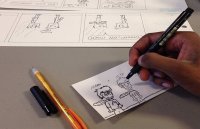Creating Comics in the Classroom
Students who learn how to make comics—even simple ones—become stronger storytellers and gain confidence in their ability to be creative.
Your content has been saved!
Go to My Saved Content.Librarians and classroom educators alike have been touting the value of using comics in the classroom for years. The fusion of words with images supports literacy development in all learners. Rich content from a variety of genres engages a range of readers, and the multimodal nature of comics and graphic novels prepares students for our evolving media landscape. These benefits are fairly well documented, and one can find article after article about ways to integrate comics as texts into any classroom.
Unfortunately, less attention has been paid to the tremendous benefit of creating comics in the classroom. Whether through doodles, collages, or digital composition, creating comics gives learners the opportunity to be active agents in their understanding. Students who put thought balloons beside their characters and decide where to put panel breaks on the page become stronger storytellers, more critical thinkers, and more effective communicators. Jacquie Gardy, who develops content for English language learners, and I developed these strategies to help global educators find accessible and flexible pathways to creating comics with students in any learning environment.
Most of these strategies need little more than pen and paper to be successful, and the others can be accomplished with found materials and a single digital device. We’ve seen them work with high school students in Maine and middle school students in Senegal, and we reckon they can help your students as well, no matter where in the world you are. The level of your students’ artistic talent doesn’t matter. In any instance, it’s helpful to allow students to build their confidence through the creation of a simple visual vocabulary.
Celebrated visual thinkers such as Austin Kleon and Sunni Brown recommend starting with six simple doodles: rectangle, triangle, oval, line, wave, and dot. We then model for students how those simple doodles can be arranged and rearranged into any number of easily identifiable objects, locations, figures, and symbols. When creating comics in front of the classroom, my characters are almost always a single oval sitting atop a triangle. Sometimes there are facial features, sometimes not. My goal is to show students that they do not need to be artists to be visual storytellers.
Empathy and Understanding
Ask your students to interview a peer, a member of their family, or someone from the community about what it feels like to be either frustrated or relieved. Some helpful prompts are questions such as, “How do other people know when you are frustrated?” and “What does your body do when you feel relieved?” Students ask their interview subject to share a story about a time when they felt that way.
Ask your students to then retell their partner’s story in a comic of four to six panels. Once those comics are completed, have the students meet in partnerships again. During a share session, students should have conversations about the extent to which their comics accurately capture the experience and feelings of the interview subject.
Idioms and Figurative Language
Cut out a wide range of people, animals, objects, or really anything that could be a character from a selection of old magazines. Then cut a variety of word balloons, thought bubbles, and even sound-effect sunbursts or polygons out of blank paper or card stock. Distribute a number of idioms to your students, and ask them to select two or three.
Have your students arrange the found images, the word balloons, and the sound effects into a four-panel comic that demonstrates the difference between the literal and figurative meanings of one of their chosen idioms.
Autobiographies and Memoirs
Access the galleries of Creative Commons–licensed icons from The Noun Project, Pixabay, or Flaticon, and ask students to identify a number of icons that represent different periods in their lives. Students might even design their own icons.
Then ask students to tell a story of their lives in a wordless comic, using the icons in place of dialogue and narration. If students feel overwhelmed by the breadth of their storytelling, consider asking them to tell an autobiographical story that either makes them smile inside or makes their insides turn to a frown. Consider having students swap stories with partners and create written translations of the icon dialogue to assess the effectiveness of their visual communication.
Conflict Resolution and Restorative Justice
Gather a selection of Lego bricks, action figures, or other posable toys for students to use as characters and scenery. Secure digital devices for your students, whether one-on-one, in small groups, or through a station-rotation design. There’s nothing wrong with a teacher cycling through the classroom and capturing the images. Adapt to the conditions that suit your learning environment and your students’ ability to access digital photos.
Ask students to use digital photography and a slide-deck creator to create comics of four panels or slides that demonstrate effective ways to resolve conflict between two or more people. Encourage students to experiment with camera angles to add meaning and then use digital tools to add word balloons, captions, and sound effects. After they have created their comics, ask students to discuss them in small groups and assess the extent to which the resolution aligns with principles of restorative practice.
Each of the above strategies may be modified or remixed to meet the needs of learners, to integrate more or less digital experience, and to be conducted in face-to-face lessons or in a remote-learning model. These are simply starting points for the creation of the comics in the classroom. By emphasizing ideas and intention over art and composition, we’ve found that comics creation fosters students’ creative confidence and ultimately their capacity to communicate.
